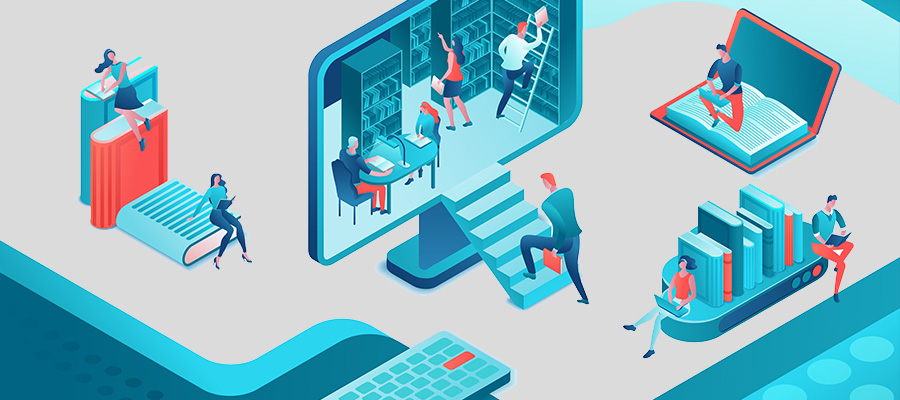Elearning has evolved significantly over the last few decades, particularly with the advent of digital technology and Web 2.0. Like any other field, it has its own jargon, which can be intimidating for anyone starting to look into it. So, before plunging into this increasingly complex world, it is worthwhile to familiarize yourself with its most commonly used concepts. Here are five of the most important ones.
What is synchronous elearning?
Synchronous elearning refers to one of the two types of interaction that can take place in an elearning environment. In this form of learning, instructors and learners do not have to be at the same location — they are online rather than in class —, but they have a direct interaction, in real-time. These resources include virtual classes, chat, instant messaging, audio and video conference.
Good to know
Elearning can combine asynchronous and synchronous interactions and tools.
Other terms used: synchronous online learning, synchronous e-learning, synchronous virtual learning
What is asynchronous elearning?
Asynchronous elearning refers to one of the two types of interaction that can take place in an elearning environment. In this form of learning, instructors and learners do not have to be at the same location, or at the same time as in the case of a classroom course. The pedagogical content and the assessments are published by ways that enable participants to choose the moment and the place to learn, interact or teach. These ways include discussion forums, tutorials, videos, interactive lectures, blogs, wikis and email exchanges.
Good to know
Elearning can combine asynchronous and synchronous interactions and tools.
Other terms used: asynchronous online learning, asynchronous e-learning, delayed-time online learning, asynchronous virtual learning, delayed interaction elearning, delayed response elearning
What is a Learning Management System (LMS)?
A Learning Management System or LMS is a software application that helps administer and/or deliver part or all of a training program. Through this application instructors can document, track, create reports and deliver a multitude of courses.
The LMS database contains the skills that each person needs to develop, the courses, the modules, and the sequence they are expected to follow to attain a desired level of competence. It also stores the grades they’ve earned.
What is Web 2.0?
The second generation of the World Wide Web, Web 2.0 allows the internauts to interact with each other, to create web content and to share information online.
Good to know
Among the Web 2.0 tools, we find blogs, social media, discussion forums, wikis, RSS feeds, sharing bookmarks and podcasting tools.
The Web and the Internet are often confused, while the first is only one of the applications of the second.
What is a discussion forum?
A discussion forum is a public and dynamic discussion space on the Internet where different people can exchange their ideas and opinions on a precise subject, in real or delayed time. A facilitator can lead the discussion. To assure the smooth running, the websites that offer a forum implement a moderation system that suppresses the messages that do not respect the usage charter or that can lead to legal repercussions.
Good to know
The discussion forum can be part of an asynchronous elearning solution.
Other terms used: forum, Internet forum
Related articles:
- Mini glossary of artificial intelligence
- Unravelling online training in 3 questions
- 7 principles of 21st-century learning and elearning
- 3 Points on Transitioning to Online Learning
- Communication tools to increase engagement in online learning
- Online Learning: Designing Assignments That Achieve Their Goal!
- Online Training: 3 Strategies for Optimizing Learners’ Workload
- Online Learning: 10 Trends for 2020
- Creating inclusive online training courses: follow the guide!
- How to assess creativity in online learning
- Online Training: 8 Anti-Cheating Strategies
- Online learning: 6 types of interactions at play
- A holistic model for student evaluation in online courses
- Sync or swim: getting comfortable with synchronous elearning
- 12 tips for adult-friendly online training
- 5 musts for motivation in online learning
- Choosing the colors of an online training
- Why aren’t your students participating on the discussion board?
- Digital Learning Governance
Author:
Catherine Meilleur
Creative Content Writer @KnowledgeOne. Questioner of questions. Hyperflexible stubborn. Contemplative yogi.
Catherine Meilleur has over 15 years of experience in research and writing. Having worked as a journalist and educational designer, she is interested in everything related to learning: from educational psychology to neuroscience, and the latest innovations that can serve learners, such as virtual and augmented reality. She is also passionate about issues related to the future of education at a time when a real revolution is taking place, propelled by digital technology and artificial intelligence.







Leave A Comment